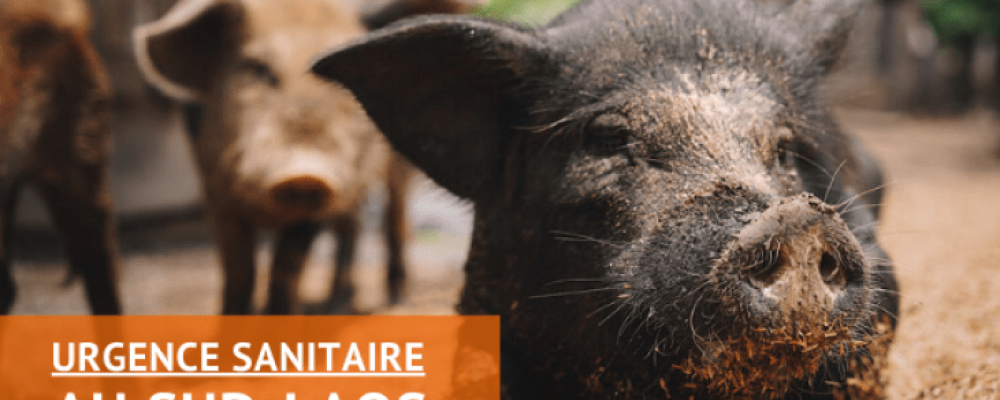“African swine fever” (ASF) is an extremely resilient virus that has spread at an accelerated path in the region since 2019: originating from China, it hit Vietnam hard since the beginning of last year before spreading to Cambodia and Laos, Burma, the Philippines, Indonesia, Timor Leste and Papua New-Guinea (see FAO cartography and OIE bulletins).
The crisis is settling worryingly in the region, and probably for a long time in the absence of a vaccine, given the resistance and contagiousness of the virus (which remains active for 6 months in carcasses even buried, or processed food, and is transmitted by footwear, tires, etc. where the virus can remain for several weeks or even months if not disinfected appropriately), and knowing that it can also be transmitted by wild fauna (wild boars and wild pigs) and that borders in the region are porous and difficult to control.
The impacts for family producers are worrying:
– Risk of food and nutritional crisis: pork is the second source of protein after fish in Lao PDR, already strongly affected by malnutrition in rural areas;
– Risk of economic and social crisis: pork is an important security capital for rural families, providing them with quick cash for the purchase of food but also for access to basic services: school, health, etc. With an average of less than one hectare of paddy rice and a single harvest per year, families cannot ensure their food self-sufficiency or generate enough income during the year, hence the importance of complementary small animals raising. Besides, the current crisis of pig value chains at regional level (deaths, mass slaughter campaigns) resulted in a price surge (for piglets, but also other meat or food products) which hampers the bargaining power of rural households but also the chances of pig repopulation in the medium-term;
– Ecological and health risks: pigs are a key factor in the transformation of household food waste into organic matter for soil fertilization, the risk being that it is replaced by chemical fertilizers, whose use is already increasing rapidly. The replacement of pigs (following their death or slaughter campaigns) by poultry, on such a large scale and in such a short period of time, also presents the risk of (re)emerging epidemics, including zoonotic animal diseases transmissible to humans (as is the case of avian influenza, still present in the region);
– Risk of disappearance of local pig value chains in certain countries, notably in Lao PDR (landlocked between two large producers: Thailand and Vietnam) for the benefit of other alternative livestock or industrial pig raisers. Yet, it should be recalled that beyond its ecological, nutritional, and economic role, pig farming and consumption are deeply rooted in local cultures and traditions. The disappearance of this sector could, therefore have major socio-cultural, and even political, repercussions.
This crisis, as in the case of most epidemics of this type, is also an opportunity for many actors to blame small family farmers while promoting an intensive/agro-industrial model supposedly more secure, although the latter is in fact a main vector for the rapid spread of animal diseases on a global scale.
In addition, it directly affects our projects in the region, jeopardizing the achievement of our objectives (fight against malnutrition, support to the structuration of local value chains) and the sustainability of our actions (including the promotion of Community Animal Health Workers/CAHWs: local breeders trained by AVSF to provide basic veterinary care for rural communities). In Lao PDR, the 3 target provinces of our AHAN project are the first to have been affected by the virus although they already suffer from chronic malnutrition, while in Cambodia the CAHWs trained and supervised for several decades by our teams are powerless to provide solutions to farmers in the face of this crisis (in the absence of training, the CAHWs treat pigs in vain as if for a Classical Swine Fever whose symptoms are mostly similar, until their death), undermining their credibility and capacity for action.
“Based in Laos, Antoine explains the epidemiological situation that threatens the food security of rural communities. He also presents the solutions provided by AVSF.
African Swine Fever (ASF)’s situation and impact in Laos: another pandemic, killing millions of domestic pigs and wild boars in Southeast Asia and threatening rural communities, Asian economies and global markets (english subtitles included).”
In parallel to this advocacy campaign, we launched in May a fundraising campaign to finance a first pilot operation in Lao PDR, according to this approach we worked on for the last months in coordination with our partners (OIE, FAO, CIRAD, local authorities). This project is expected to start in November, just after the rice harvests, under our AHAN project area (https://www.avsf.org/en/posts/2456/full/african-swine-fever-the-other-pandemic)

